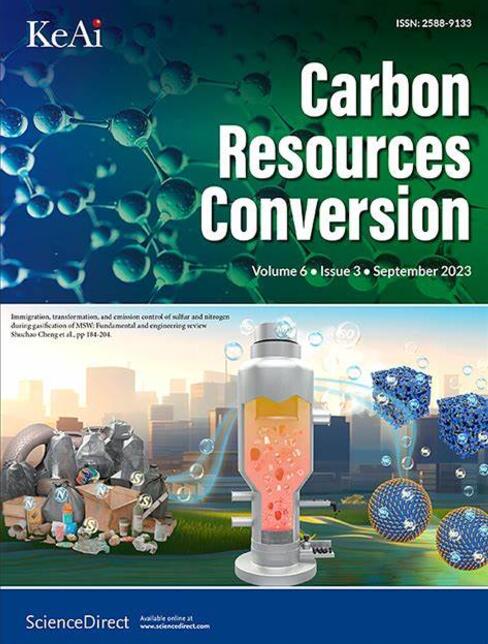用于高功率密度超级电容器的马尼洪块茎和青竹茎的3d多孔活性炭形态改性:生物质废弃物到可持续能源
IF 7.5
3区 环境科学与生态学
Q2 ENERGY & FUELS
引用次数: 0
摘要
生物质活性炭是一种环保、低成本的超级电容器电极材料。活性炭的不同形态和孔隙形状对提高超级电容器的存储容量有显著影响。然而,活性炭中不同孔径的分布对能量密度有负面影响。本研究采用声化学辅助水热法,以0.06 M KOH, 0.06 M PVP, 0.06 M ZnCl2为原料,合成并改性了马尼洪和青竹茎的碳孔结构。0.06 M ZnCl2修饰后的样品三维孔结构具有良好的微孔结构,比表面积达到516.29 m2−1,具有优异的纽扣电池超级电容器电化学性能。在2v的电压窗下,获得了1086.12 Wkg−1的高功率密度,对应的电流密度为0.3 Ag−1。值得注意的是,经过5000次充放电循环后,电容保持率保持在90.8%。以0.06 M ZnCl2改性的马尼特块茎和竹茎为原料制备高功率密度生物质活性炭,为环保储能装置和实现快速大规模运输提供了切实可行的途径。本文章由计算机程序翻译,如有差异,请以英文原文为准。

3D-porous activated carbon morphological modification of Manihot esculenta tuber and Bambusa blumeana stem for high-power density supercapacitor: Biomass waste to sustainable energy
Activated carbon derived from biomass is an environmentally friendly and low-cost supercapacitor electrode material. The diverse morphology and pore shape of activated carbon have a significant impact on enhancing the storage capacity of supercapacitors. However, the disparate distribution of pore sizes in activated carbon has a negative effect on energy density. In the present study, the synthesis and modification of the carbon pore structure of Manihot esculenta tuber and Bambusa blumeana stem was carried out using a sonochemical-assisted hydrothermal method with various chemicals (0.06 M KOH, 0.06 M PVP, 0.06 M ZnCl2). The 3D pore structure of the sample modified with 0.06 M ZnCl2 exhibited a well-defined microporous architecture and a substantial specific surface area of 516.29 m2g−1, leading to excellent electrochemical performance in coin cell supercapacitors. A high power density of 1086.12 Wkg−1 at a voltage window of 2 V has been attained, with a corresponding current density of 0.3 Ag−1. Remarkably, after 5000 charge and discharge cycles, the capacitance retention was maintained at 90.8 %. The high power density produced from biomass activated carbon based on Manihot esculenta tuber and Bambusa blumeana stem modified using 0.06 M ZnCl2 provides a practical approach for environmentally friendly electrical energy storage devices and realizes rapid mass transportation.
求助全文
通过发布文献求助,成功后即可免费获取论文全文。
去求助
来源期刊

Carbon Resources Conversion
Materials Science-Materials Science (miscellaneous)
CiteScore
9.90
自引率
11.70%
发文量
36
审稿时长
10 weeks
期刊介绍:
Carbon Resources Conversion (CRC) publishes fundamental studies and industrial developments regarding relevant technologies aiming for the clean, efficient, value-added, and low-carbon utilization of carbon-containing resources as fuel for energy and as feedstock for materials or chemicals from, for example, fossil fuels, biomass, syngas, CO2, hydrocarbons, and organic wastes via physical, thermal, chemical, biological, and other technical methods. CRC also publishes scientific and engineering studies on resource characterization and pretreatment, carbon material innovation and production, clean technologies related to carbon resource conversion and utilization, and various process-supporting technologies, including on-line or off-line measurement and monitoring, modeling, simulations focused on safe and efficient process operation and control, and process and equipment optimization.
 求助内容:
求助内容: 应助结果提醒方式:
应助结果提醒方式:


